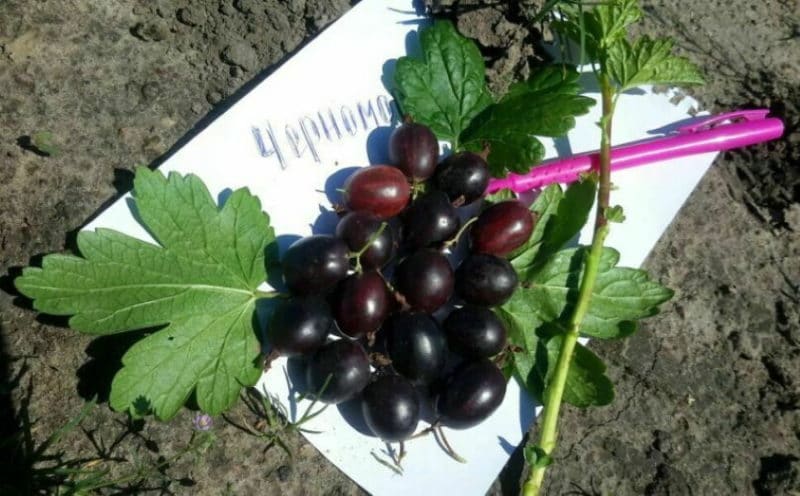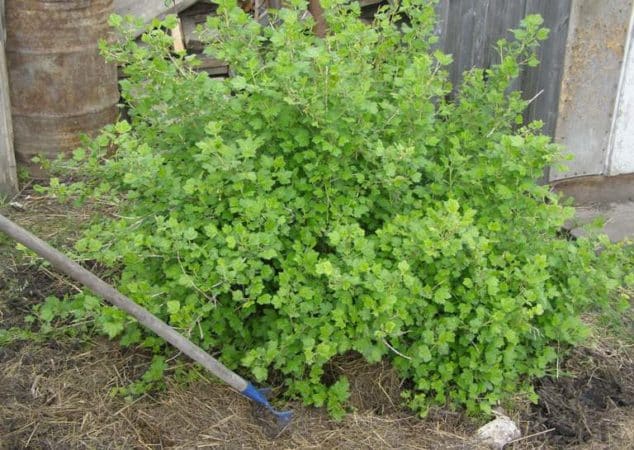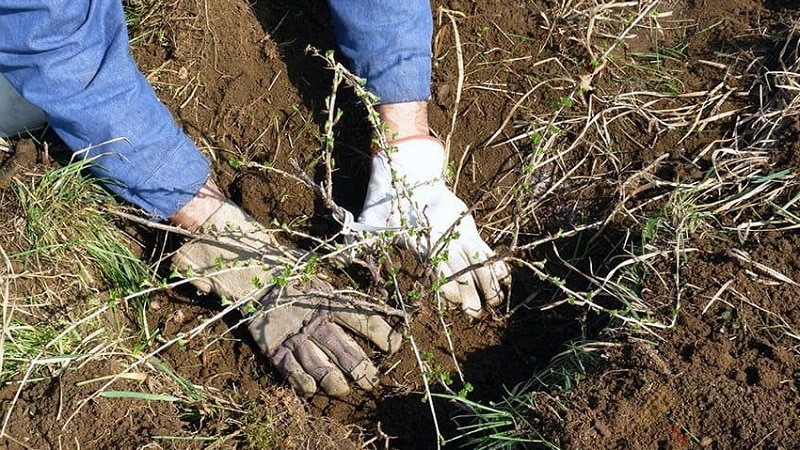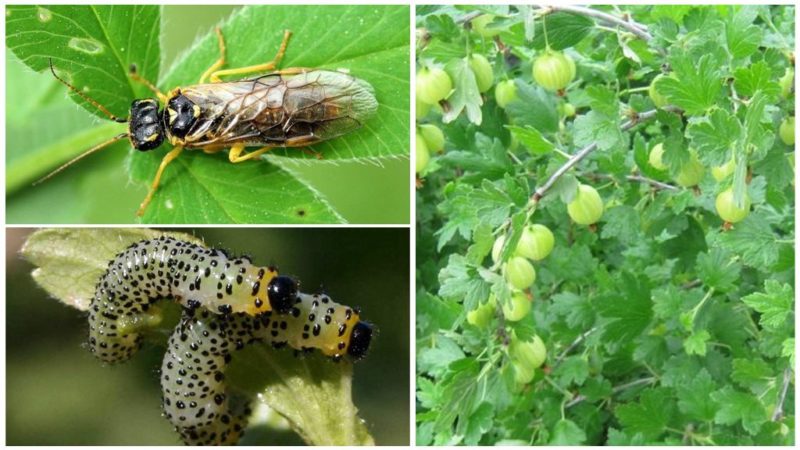Disease- and pest-resistant, easy-to-care gooseberry variety Chernomor
Chernomor is a gooseberry variety of Russian selection, loved by gardeners due to its many advantages and almost complete absence of disadvantages. Its fruits are characterized by juiciness, a pleasant sweet and sour taste and the possibility of universal use, and the bushes are resistant to diseases and adverse weather conditions. Let's take a closer look at the description of the variety and the features of its cultivation.
What kind of gooseberry is this?

Chernomor is a mid-late gooseberry variety ripening period. The bushes begin to bear fruit 2 years after planting, the berries ripen in the 1st-2nd decade of July. Productivity is high: minimum - 2.1 kg/bush, maximum - 4 kg/bush, or 10 t/ha.
Reference. Other names for Chernomor are Northern Grape and Garden Date.
The berries are sweet and sour; 100 g of fruit contains 29.3 mg of vitamin C, 8.4–12.2% sugars, 1.7–2.5% titratable acids, 5.6–6.8% pectin.
For recycling berries are picked 14 days before ripening, when they are still green. For fresh consumption, the harvest is harvested when the fruits reach full ripeness and turn dark burgundy. In the first case, gooseberries are stored in the cellar or refrigerator for up to 2 weeks, in the second - no more than 7 days.
History of origin and distribution
Chernomor was bred by K. D. Sergeeva at the All-Russian Research Institute named after. I.V. Michurina as a result of pollination of Seedling 21-52 with a mixture of pollen from the varieties Finik, Green Bottle, Brazilian and Seyanets Maurera.
The variety has been under state variety testing since 1980, included in the State Register of Breeding Achievements of Russia in 1994 with permission for cultivation in the Central region (Ivanovo, Tula, Vladimir, Kaluga, Bryansk, Moscow, Ryazan and Smolensk regions).
Gooseberry Chernomor: characteristics and description of bushes

Chernomor has a compact, vigorous bush, reaching a height of 1.5 m. The crown is dense, the shoots are straight, hairless, light green, with an anthocyanin tint at the top, covered at the bottom with dark single sparse and thin spines of short or medium length, growing downwards.
The buds are small, hairless, oval with a sharp tip. The leaves are medium-sized, dark green, with a convex, hairless, shiny, smooth or folded surface. They have a three- or five-lobed shape and a straight or shallowly notched base.
The petiole has sparse glandular pubescence from below; the angle between it and the shoot is 30°. The inflorescence consists of 2 or 3 flowers with free, slightly elongated bright sepals. The ovary is anthocyanin colored, slightly pubescent.
Temperature resistance
This is a frost-resistant variety: with proper preparation for winter, the bushes can withstand frosts of -25...-30°C, so they are successfully grown throughout Russia.
Moisture and drought resistance
Thanks to the deep penetration of roots into the soil, Chernomor calmly tolerates long-term drought. Excessive watering, waterlogging of the soil and the occurrence of groundwater close to the surface lead to rotting of the root system and death of the plant.
Resistance to diseases and pests
The variety is resistant to powdery mildew and fire. The dangers for it are aphids, sawflies and moths.
Characteristics and description of fruits
The berries are oval or round-oval, weigh on average 3 g, are hairless, covered with a not too dense but durable skin with a waxy coating. The color is dark red, becoming almost black when fully ripe.
The veins are slightly branched, lighter than the main color, and become almost invisible when the berries reach full ripening.
The pulp is juicy, sweet and sour with a predominant sweetness in taste. Tasting rating of berries - 4.3, jam - 4.4, juice - 4.7 points out of 5.
Areas of use
Chernomor fruits are consumed fresh, used for making jams, juices, preserves, jelly, marmalade, wine, sauces, kvass, jelly, and added to baked goods.
Gooseberry Chernomor: advantages and disadvantages of the variety
The main advantages of Chernomor:
- excellent taste;
- the possibility of universal use of the crop;
- good transportability;
- precociousness;
- resistance to drought, frost, powdery mildew and moth;
- undemanding to soil;
- possibility of mechanized harvesting;
- good survival rate.
Among the disadvantages of Chernomor are the small size of the fruits, the tendency for the bush to thicken and the berries to bake when exposed to the sun for a long time.
Growing technology
Chernomor is undemanding to soil composition. For its successful cultivation, the main thing is to choose a suitable place on the site and provide proper care.

Optimal conditions
For planting Chernomor, choose a well-lit area, protected from drafts, located on a plain or hill.
The soil should be light and loose, allowing air and moisture to pass through. The ideal option is forest-steppe soil, medium or light loam. The variety grows well on sandstones, peat bogs and in soddy-podzolic soil.
Reference. The optimal depth of groundwater is no higher than 1.5 m.
It is better to choose a two-year-old seedling, with an open root system, without damage or signs rotting and diseases. The plants in the pot should have a lot of white roots, and the length of the shoots with leaves should be 40–50 cm.
Before planting, the seedlings are pruned: the tips of the roots and all dry or damaged areas are removed, the branches are shortened so that 5-6 buds remain on them. The roots are soaked for at least 3 hours in a solution of a growth stimulator (Kornevina, Epina) and dipped in a mixture of mullein and clay.
Landing dates and rules
Plants are planted on the plot in early spring (before sap flow begins) or in autumn (late September - early October).
Landing rules:
- Dig planting holes 30–40 cm deep.
- Prepare a nutrient mixture (10 kg of compost, 50 g of double superphosphate, 100 g of ash and 40 g of potassium sulfide), pour it onto the bottom of the hole and form a hill.
- Place the seedling on it, carefully spread the roots along the slopes.
- Fill the holes with soil so that the root collar is buried a maximum of 5 cm.
- Water the plantings at the rate of 10–12 liters for each seedling.
- Mulch the ground with peat or sawdust.
The optimal distance between bushes is 1.2–1.5 m, between rows - 2 m.
Further care
Water the gooseberries as needed, based on weather conditions and soil type. Be sure to moisturize during the following periods:
- before flowering begins;
- during the formation of ovaries;
- before fruit ripening;
- after harvest;
- before wintering.
Water is poured strictly at the root. Moisture on the leaves provokes the development of diseases.
After each watering, the soil around the bushes is loosened to improve its aeration, moisture permeability and to avoid the formation of a dry crust on the surface.
They begin to feed the bushes 4 years after planting. Once every 3 years, 150 g of superphosphate, 40 g of potassium sulfate, 200 g of wood ash and 10 kg of organic fertilizers, for example, rotted manure, are added to each plant. Every year, in early May, Chernomor is fertilized with urea (15 g per bush, after the flowering period - 10 g).
In the second year of cultivation, the bushes are pruned, leaving 4 skeletal branches growing opposite each other. Every year, cut off all old, damaged, dry shoots that thicken the crown and grow inward. The procedure is carried out in the spring, before the beginning of the growing season, or in the fall.
Possible problems, diseases, pests

Chernomor has good immunity and is resistant to most diseases characteristic of the culture. Immune to powdery mildew and moths.
To prevent fungal diseases in the spring, gooseberries are treated with Topaz, Tiovit Jet or Karbofos solution.
Among pests pose a danger to Chernomor aphid, sawflies and moths. To protect against insects, plants are sprayed 3-4 times with “Samurai”, “Fufanon” or “Tsiperus” during the growing season.
Wintering
Despite the frost resistance of the variety, it is important to prepare the bushes for winter. To do this, the soil between the rows is weeded, cleared of debris and plant debris and loosened to a depth of 15–18 cm. After this, water-recharging irrigation is carried out (30–40 liters of water per 1 m²) and the tree trunk circle is mulched with a layer of peat or sawdust.
Features of cultivation depending on the region
Chernomor's requirements for planting and care do not depend on the growing region.However, in areas where the climate is hotter and drier, more abundant and frequent watering is carried out, and in regions with frosty winters, bushes are covered with agrospan in late autumn, which is not necessary, for example, in Central Russia.
Reproduction
Gooseberry Chernomor is propagated by cuttings or horizontal layering.
Two-year-old shoots are used for cuttings. They are cut into pieces 12–15 cm long, treated with a growth stimulator (“Kornevin”) and planted in a mixture of peat, sand and garden soil.
Reference. Rooted cuttings and layering are planted in a permanent place in the fall, no later than a month before the onset of frost.
When propagating by horizontal layering, a healthy shoot is selected from the bush, tilted towards the ground and placed in a pre-dug ditch. Then they secure it with a bracket, sprinkle it with earth and water it.
Pollinator varieties
Chernomor is a self-pollinating gooseberry variety, i.e. it does not need pollinating plants to bear fruit. To increase its yield, other varieties with the same flowering periods (late April - mid-May) are planted nearby.
Reviews from summer residents
Gardeners speak positively about Chernomor.
Maria, Tula: “In my opinion, this is the best variety of gooseberry. It has been growing on the site for many years, it bears fruit consistently, the harvest is large, and the bushes have never gotten sick. Of course, I carry out preventive treatments, but I think it’s not only this, but also the high immunity of the plant.”
Irina, Moscow region: “Gooseberries are my favorite berry. I used to buy it all the time, and when the plot became available, I planted several bushes. On the advice of friends, I chose Chernomor and I don’t regret it. The berries are very tasty, aromatic, they are a pleasure to eat fresh, and the jam turns out excellent.The seedlings took root quickly and began bearing fruit the very next year. The bushes do not get sick and are resistant to cold and drought.”
Valery, Bryansk: “Chernomor is definitely one of my top five favorite gooseberry varieties. Apart from the rather small berries, I don’t see any shortcomings in it. The bushes are compact, and with proper and regular pruning they become a real decoration of the site. They don’t get sick, pests don’t attack them, they bear fruit well, and the yield is high every time.”
Conclusion
Chernomor is a gooseberry variety popular among gardeners, characterized by a pleasant sweet and sour taste of the fruit, immunity to powdery mildew, good survival rate of seedlings, and drought and frost resistance. The only disadvantages include the small size of the berries and the need for regular pruning of the bushes due to their tendency to thicken.